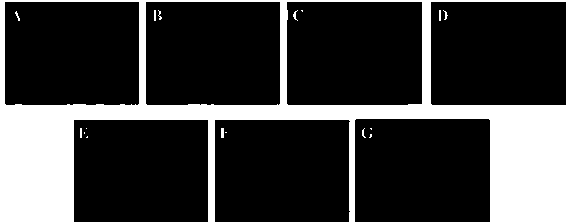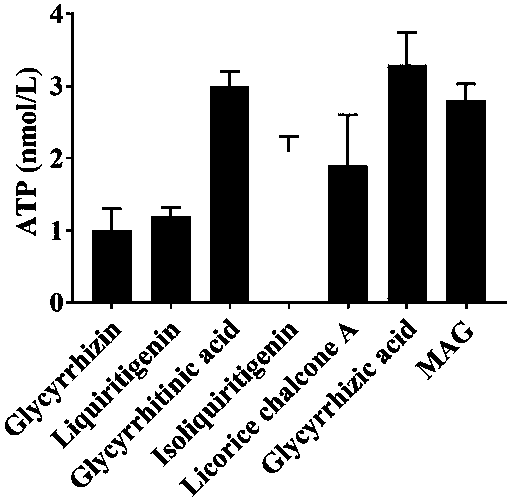New medicinal application of effective components and derivatives thereof in Glycyrrhiza uralensis
A technology of active ingredients and derivatives, applied in the field of medicine, can solve problems such as large side effects and damage to human cell activity
- Summary
- Abstract
- Description
- Claims
- Application Information
AI Technical Summary
Problems solved by technology
Method used
Image
Examples
Embodiment 1
[0029] Mouse colon cancer cells were cultured in the drug environment, and cell proliferation was detected by CCK-8. The reagent contains WST-8 [chemical name: 2-(2-methoxy-4-nitrophenyl)-3-(4-nitrophenyl)-5-(2,4-disulfonic acid benzene )-2H-tetrazolium monosodium salt], which is reduced by the dehydrogenase in the cell to have Highly water-soluble yellow formazan product. The amount of formazan produced is directly proportional to the number of living cells. This feature can therefore be used directly for cell proliferation and toxicity assays. Specific steps are as follows:
[0030] Step 1: Inoculate CT-26 cell suspension (mouse colon cancer cells) in a 96-well culture plate and culture for 1 day until the density of the cell monolayer is 60%;
[0031] Step 2: Incubate with DMEM culture solution for 15 minutes, add a series of DMSO solutions of different concentrations of liquiritin, glycyrrhizin, glycyrrhetinic acid, isoliquiritigenin, licochalcone A, glycyrrhizic acid ...
Embodiment 2
[0035] Mouse colon cancer cells were cultured in the drug environment, and the transfer of CRT from the endoplasmic reticulum to the cell membrane surface was detected by immunofluorescence. CRT is a calcium-binding protein present in the endoplasmic reticulum, involved in folding during protein synthesis, and by binding Ca 2+ Increases Ca in the endoplasmic reticulum 2+ stability. During apoptosis, CRT is exposed to the tumor microenvironment, recruits and stimulates the maturation of antigen-presenting cells with the "eat me" signal, binds to surface receptors, and stimulates Rac-1 to promote the phagocytosis of tumor cells. The everted extramembrane expression of CRT is critical for triggering T cell-dependent antitumor immunity. Specific steps are as follows:
[0036] Step 1: Inoculate CT-26 cell suspension (mouse colon cancer cells) in a 6-well culture plate and culture for 1 day until the density of the cell monolayer is 60%;
[0037] Step 2: Incubate with DMEM cultu...
Embodiment 3
[0042] Mouse colon cancer cells were cultured in drug environment, and ELISA was used to detect the release of HMGB1. HMGB1 is widely distributed and is a cytokine related to inflammatory response, which is highly expressed in the nucleus and regulates chromatin structure and gene transcription. At homeostasis, HMGB1 shuttles between the cytoplasm and nucleus. In the late stage of ICD, due to the damaged nucleus and plasma membrane, HMGB1 is exposed on the surface of apoptotic cells, binds to many receptors on antigen presenting cells (APC), and activates the inflammatory pathway response. Specific steps are as follows:
[0043] Step 1: Inoculate CT-26 cell suspension (mouse colon cancer cells) in a 6-well culture plate and culture for 1 day until the density of the cell monolayer is 60%;
[0044] Step 2: Incubate with DMEM culture medium for 15 minutes, add liquiritin, glycyrrhizin, glycyrrhetinic acid, isoliquiritigenin, licochalcone A, glycyrrhizic acid and DMSO solution ...
PUM
 Login to View More
Login to View More Abstract
Description
Claims
Application Information
 Login to View More
Login to View More - R&D
- Intellectual Property
- Life Sciences
- Materials
- Tech Scout
- Unparalleled Data Quality
- Higher Quality Content
- 60% Fewer Hallucinations
Browse by: Latest US Patents, China's latest patents, Technical Efficacy Thesaurus, Application Domain, Technology Topic, Popular Technical Reports.
© 2025 PatSnap. All rights reserved.Legal|Privacy policy|Modern Slavery Act Transparency Statement|Sitemap|About US| Contact US: help@patsnap.com



